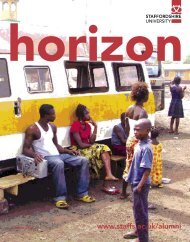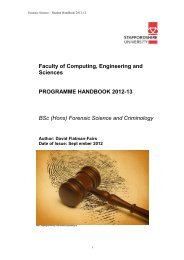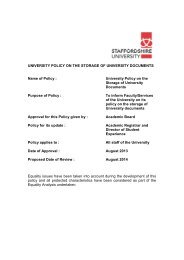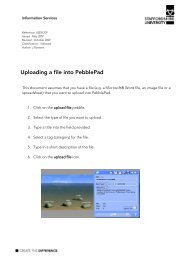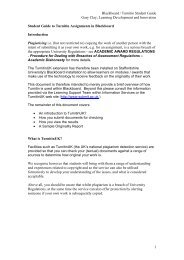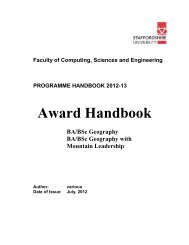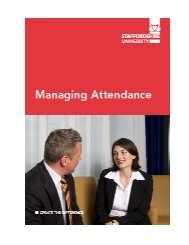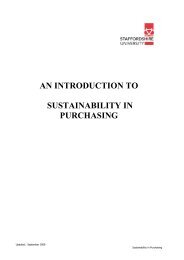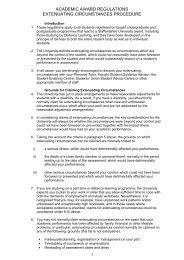DICE Project Final Report Resource Discovery Tools Evaluation and ...
DICE Project Final Report Resource Discovery Tools Evaluation and ...
DICE Project Final Report Resource Discovery Tools Evaluation and ...
Create successful ePaper yourself
Turn your PDF publications into a flip-book with our unique Google optimized e-Paper software.
<strong>DICE</strong> <strong>Final</strong> <strong>Report</strong><br />
other RD tools however, Scholar might identify resources which depend on subscription, so while<br />
the resource might be accessible it may not be available for immediate access. Other RD tools<br />
described here can return ‘resolved’ references by providing additional services in adapting the<br />
service to particular requirements (Google Scholar, GetRef, ZETOC) but their focus might be more<br />
on discovery than resolution.<br />
• Implementation of RD tools <strong>and</strong> services<br />
It is as well to make the point here (at least for those concerned with technical support) that the way<br />
resource discovery is achieved is largely hidden from users <strong>and</strong> (so) we have referred loosely to<br />
‘tools’ or to ‘tools <strong>and</strong> services’, but these are not the same thing. A tool (or toolkit) may be available<br />
for installing <strong>and</strong> local implementation (providing a local service) <strong>and</strong> this will require some<br />
technical expertise <strong>and</strong> resources (a computer to run the server software). The main advantages of<br />
a local implementation are the facility to customize the software to the particular requirements of an<br />
institution or community of practice, <strong>and</strong>, more generally, that the control of the service is managed<br />
locally (e.g. options in running the software: when, where, <strong>and</strong> how to run it). On the other h<strong>and</strong>, we<br />
have said RD can be easily embedded as a simple link in most VLEs or learning portals, but this<br />
may depend on a service provided by some third party (if the server software is managed<br />
elsewhere): there isn’t necessarily any guarantee that the service would be reliable or maintained in<br />
the long term. One advantage of using a service, of course, is that the responsibilities <strong>and</strong> costs<br />
relating to management of the service rest with a third party.<br />
With these points in mind, we are almost ready to explore some RD tools in more detail. There are<br />
further issues to consider, most notably how RD tools might be integrated with VLEs but these<br />
relate rather more to the future development of RD tools <strong>and</strong> Advanced Topics.<br />
<strong>Evaluation</strong> of RD <strong>Tools</strong><br />
The first task is to determine whether such tools <strong>and</strong> services are of benefit in their own right, <strong>and</strong><br />
what are considered essential or desirable features. Our focus is will be on the D+ <strong>and</strong> DEVIL<br />
tools, comparing these with the other tools to underline significant features <strong>and</strong> differences.<br />
D plus<br />
<strong>Discovery</strong>+: Brokerage for Deep <strong>and</strong> Distributed e-Learning <strong>Resource</strong> <strong>Discovery</strong>, see<br />
http://devil.lib.ed.ac.uk:8080/dplus/<br />
The toolkit is easy to install (Windows) <strong>and</strong> has a simple interface which allows discovery of quality<br />
resources from a range of targets including peer-reviewed subject-specialist gateways, learning<br />
object <strong>and</strong> e-print repositories, individual library <strong>and</strong> union catalogue databases e.g. COPAC is the<br />
merged online (combined open public access) catalogue of major UK <strong>and</strong> Irish university libraries,<br />
plus the British Library <strong>and</strong> the National Library of Scotl<strong>and</strong>. It can be configured to use a much<br />
wider range of targets, as listed at UKOLN (see the project website for further details). As the<br />
toolkit is open-source software, costs are minimal <strong>and</strong> features can more easily tailored to suit the<br />
needs of individual institutions.<br />
35



